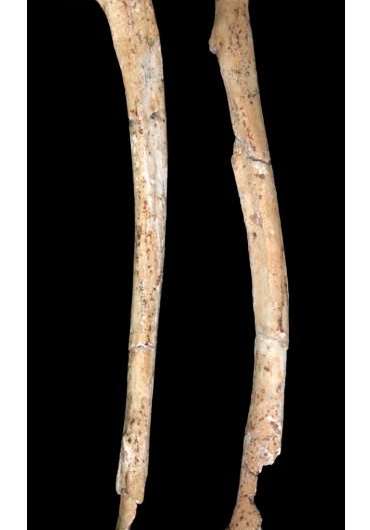December 10, 2018 report
Researchers suggest 'Little Foot' is an entirely new species of early human

Several teams of researchers have announced that the skeletal remains of a hominin believed to have lived approximately 3.67 million years ago represent a new species of early human. The researchers report that the specimen, known as "Little Foot," has characteristics that make it unlike any other known species.
The skeleton first became known when Ronald Clarke of the University of Witwatersrand looked through a bone collection back in the 1990s—he came across foot bones that were labeled as monkey bones. After determining that they were not ape, he and colleagues ventured to the Sterkfontein caves near Johannesburg in 1994, where the bones had been found, and began digging. Because of the challenges involved, it took the team approximately 10 years to fully extricate the skeleton from the rock in which it was embedded. It took another 10 years to fully clean and study the skeleton. Four teams with ties to Clarke have written papers describing aspects of the skeleton, all of which conclude that it represents a unique species. Clarke and his team have therefore given it a name: Australopithecus Prometheus. The researchers are offering some details of their findings as their papers make their way first onto bioRxiv, and then presumably into a journal.
The researchers report that the skeleton was from an elderly woman with an arm bowed due to injury. They also report that the woman would have stood just over four feet tall and had legs that were longer than her arms—a hallmark of bipedalism. She was also vegetarian. The details regarding the skeletal remains have been released prior to publication because other groups have recently been granted access to the remains, and the original team does not want to be scooped.
The researchers have told the press that Little Foot's face is flatter than the faces of members of A. africanus (which includes Lucy). There are also other differences in skull shape and tooth arrangement and size. They suggest differences in the hip bone alone are enough to support their claim that Little Foot is a new species.
More information: Robin Huw Crompton et al. Functional Anatomy, Biomechanical Performance Capabilities and Potential Niche of StW 573: an Australopithecus Skeleton (circa 3.67 Ma) From Sterkfontein Member 2, and its significance for The Last Common Ancestor of the African Apes and for Hominin Origins, (2018). DOI: 10.1101/481556
Ronald J Clarke et al. The skull of StW 573, a 3.67 Ma Australopithecus skeleton from Sterkfontein Caves, South Africa, (2018). DOI: 10.1101/483495
Laurent Bruxelles et al. A multiscale stratigraphic investigation of the context of StW 573 Little Foot and Member 2, Sterkfontein Caves, South Africa, (2018). DOI: 10.1101/482711
A.J. Heile et al. Bilateral Asymmetry of the Forearm Bones as Possible Evidence of Antemortem Trauma in the StW 573 Australopithecus Skeleton from Sterkfontein Member 2 (South Africa), (2018). DOI: 10.1101/486076
© 2018 Science X Network





















